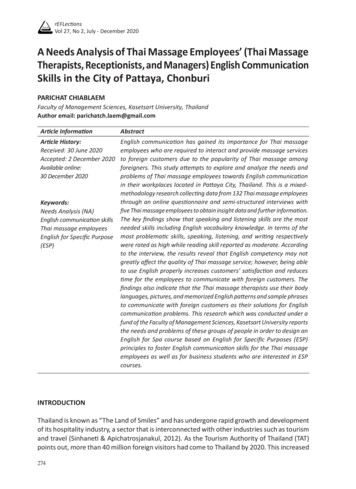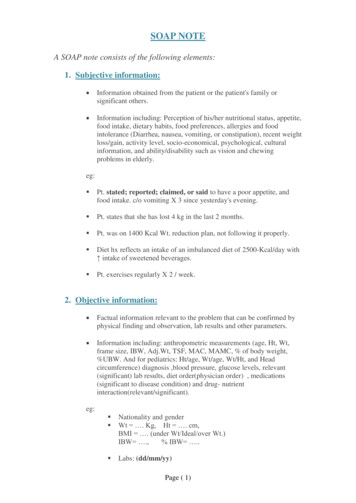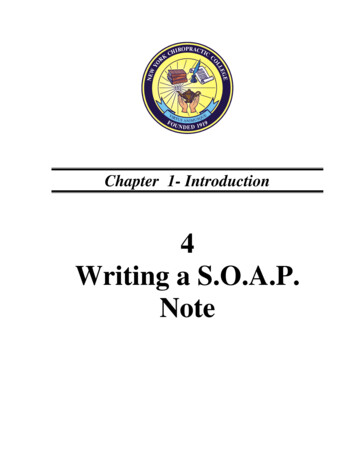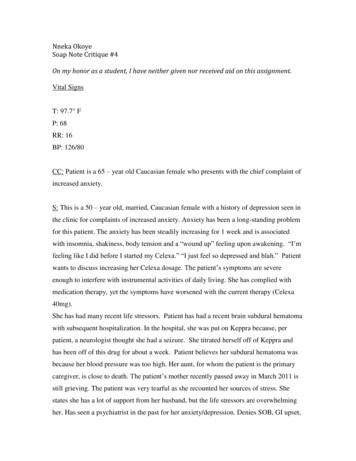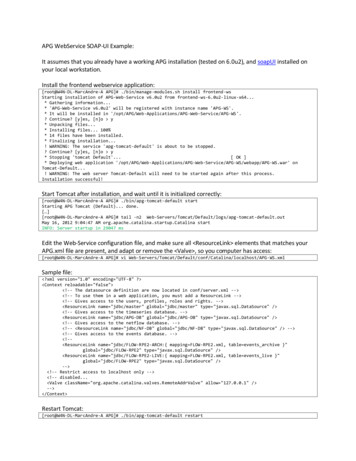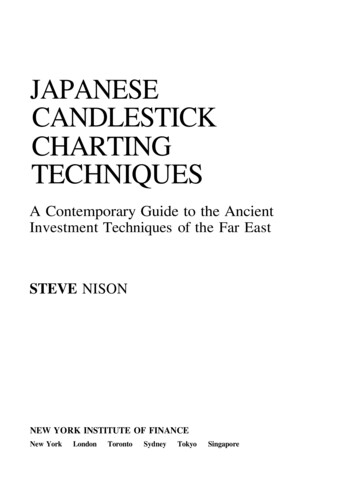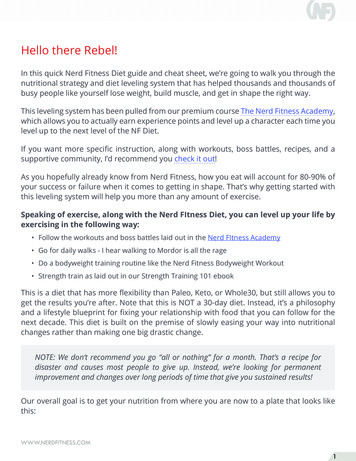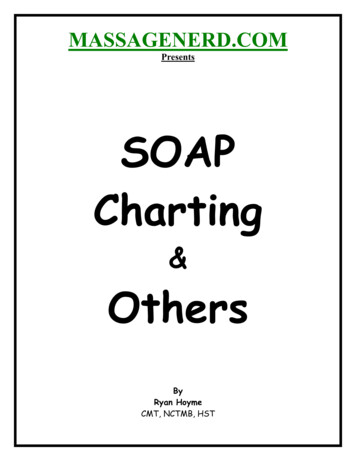
Transcription
MASSAGENERD.COMPresentsSOAPCharting&OthersByRyan HoymeCMT, NCTMB, HST
INDEX1. ACQUIRING INFORMATION (4)2. CHARTING BASICS (6)3. SOAP CHARTING (8)4. HOPS CHARTING (10)5. CARE CHARTING (10)6. FOCUS CHARTING (11)7. DISCLAIMERS (12)8. ABBREVIATIONS (13)9. INFORMED CONSENT (14)10. FEEDBACK FORM (15)11. HEALTH FORM (16)12. HEALTH QUESTIONNAIRE (17)13. LARGE PRINT HEALTH FORM (18)14. PAIN CHART (19-20)15. SOAP CHARTS (21-32)16. NEW CLIENT CHECK LIST (33)17. POSTURE CHARTS (34-39)Go to www.sohnen-moe.com/forms.html for many formsLegal DisclaimerAll models are at least 18 years of age. The techniques, ideas, and suggestions in this document are not intended as asubstitute for proper medical advice! Consult your physician or health care professional before performing or receivinga massage, particularly if you are pregnant or nursing, or if you are elderly, or if you have any chronic or recurringconditions. Any application of the techniques, ideas, and suggestions in this document is at the reader's sole discretionand risk.The author and publisher of this document and their employers are not liable or responsible to any person or entity forany errors contained in this document, or for any special, incidental, or consequential damage caused or alleged to becaused directly or indirectly by the information contained in this document.Copyright 2001-06 Ryan Jay Hoyme2
3
ACQUIRING INFORMATIONThe primary goals of acquiring a client's history are to accurately determine the origin of the person's problem andits impact on the person's life.Remember to LISTEN to your client, and let those responses guide your interview: Make every effort to be as sure as is possible that you understand what your client is trying to tell you. Be ready to recognize from your clients’ communication any gaps they leave which you the therapist shouldendeavor to fill by asking appropriate questions. Make use of every possible opportunity to use your non-verbal expressions to show your understanding andconcern for the client.The questions that the therapist asks should be, for the most part, open-ended in that they require more than a yesor no response. This allows clients to describe their circumstances in their own words.Questions about the client’s problem: What brings you to physical therapy? (if not obvious) Location: "Where is it located?" Indicate the primary area of pain.If the person uses:o Finger: indicates a small area, no spreading of discomfort, problem probably not severe, relatively superficial,or both.o Whole hand: diffuse area as primary site : suggests lesion is more severe, more deeply situated, or botho Moving hand: spreading or radiating of the pain : if along a well-defined pathway : dermatome: probably nerveroot problemo General area, diffuse: most likely referred pain, possibly visceral in originOnset: "How and when did it occur?" (Include a description of the mechanism and position of injury.)How and when did the problem arise (mechanism of injury and date of onset)?o Gradual versus sudden onseto Sudden onset.o GradualPosition the person was in when the injury was acquired (whether sudden or gradual onset).Have you started any out-of-the-ordinary activities recently?ooooo4Characteristics: "Describe your problem," "How does it feel (pain or other symptoms) and how does it makeyou feel?" "Does your problem occur at certain times?"Intensity: "How bad is your problem?" (What impact does this problem have on your life? What are you unableto do because of this problem, with respect to all aspects of your life: self-care, home, work, and leisure?)Have the client rank the problem, using a scale, such as 0 to 10 (give criteria for 0 and for 10, such as 0 atits best, 10 at its worst).Duration: "If certain activities cause you pain, how long does it last after you stop the activity?" "Is itconstant, or intermittent?"Aggravating factors: "What makes the problem worse?" "What do you notice this problem to be associatedwith?" When do you typically feel the pain?Alleviating factors: "What makes the problem better?"
Assess the Impact of the Problem on the Person's Life:Questions about the person should focus on the activities that the person performs and the environments in whichthey perform them. The activities should address home, work, and leisure/play and should reflect a typical day forthe client. "Tell me about yourself." "Tell me about your home life." (What physical activities do they have to perform at home, describe the homeenvironment, is the person married, do they have children. etc.) "Tell me about your work." (What physical activities do they have to perform, describe the work environment,etc.) "What do you like to do in your spare time?" (Describe the physical activities and their environments relatedto hobbies, recreation, etc.) "Prioritize the activities from each of these areas that you want to return to doing." "Describe your ‘typical day’ before your problem and after your problem."Additional Questions: What is it that this problem is keeping you from doing that you want to get back to doing?" This is theclient's Outcome Statement. (Have the client prioritize those affected activities, from most to leastimportant). "Do you have any other problems?" "What medications are you currently taking?" "Have you had any previous physical therapy?" (If yes, describe; was it successful?) "How do you feel right now?" "Is there anything else you would like for me to know?"During the interview and subsequent treatment, therapists continually seek to gather information from their clients5
CHARTING BASICSSOAP Charting FormatA medical charting system, in which:S Subjective (what the client says, or subjective impressions).O Objective (what the provider's findings are, or clinical data).A Assessment (Any changes, the diagnosis, or what the client's condition is).P Plan for the next treatment, (further studies and suggested treatment).Note: Not noted in the usual SOAP format, but nonetheless important, is Functional Outcome: What the client can do (orexpect to do) because of the treatment rendered. Which charting format is best - Any charting format will do in a jury trial.Reasons for chartingOther health care professionals find the format and language familiar and it is a good way to communicate with otherhealth care professionals. Use of charting enhances the image of massage and charting validates massage as curative adjunctivetreatment by providing client progress.Insurance companies accept it as proof of reasonable care and it provides evidence for attorneys as proof of significantinjury. It suggests a structure for research using case studies. The main reason is: “Memory is limited and if it is not written, itdid not happen.”Rules for charting Chart in chronological order Black ink (Blue is sometimesacceptable) Write clearly, concisely and legible No ditto marks or initials Do not skip lines Use correct grammar and spelling. Write objectively (no bias, opinions,judgments) Draw a line through empty space Include the Date, Session #, Timestarted and Length of session in theleft hand corner Re-date your entry if moving ontoanother page Write notes ASAP after giving themassage treatment Sign the end of the chart with yourfirst name, last name andprofessional title Use phrases – not full sentences. Client’s name must be on every page. Use correct terms and abbreviations. Name of client, physician and page #all can go on the top right corner The person who observed anoccurrence or completed aprocedure, records it. Use quotes around what the clientsaid Never alter therapy records Some people say to keep your filesfor 7 yearsDON’T Don’t: Write biases, value judgments, and opinions.Don’t: Write generalizations (I.e. good, fair, usual, large)Don’t: Erase, use write out, or scribble out an error. Instead draw a single line through entry, write error above it and initial.Don’t: Use erasable or colored inkDon’t: Double chart - info only needs to be in one placeDon’t: Squeeze information in – stead write on next available space. Write what and when info occurred. Then document timeof entry.When to chartThe best time to chart the Subjective part is when the client is getting undressed; the Objective part can be chartedwhen, the client is getting dressed. The Assessment and Plan part can be charted when, the client leaves. It is always best not toleave SOAP notes uncharted over night, because you can and will forget what your treatment entailed.FilingPut your files in alphabetical order with last name first and always put their name on the soap notes. Some people color coatthe files for men and women to make it easier. If you have not seen a client for 6-12 months, place them in another file system(But leave them in your office). Never leave the files around for the client to see them.CommunicationCommunication skills are used in listening, speaking, writing, and assessing non-verbal messages. To summarize is brieflystating what the client said and clarify is asking the client more information. When you use exploring, it is going over intake-form6
with the client and discovering new facts. When you are not sure what the client said you might need to paraphrase (in otherwords, what you are saying is ).Open-end and Closed-end questionsClosed-end questions are questions that you ask the client that require a yes or no answer. Closed-end questions do notget the whole story and you need to ask a lot more questions. Here is an example: Are you hurting today Do you want a relaxingmassage today?Open-end questions are questions that you ask the client that require more that a yes or no answer. Open-end questionsare more valuable and more useful in determining what the client wants. Here is an example: Where do you feel the pain rightnow Where does the pain start?AbbreviationsThe use of abbreviations can be useful to expedite charting, but be sure that everyone reading the chart knows whatthe abbreviations mean. The problem with abbreviations is that they are not regulated and people make their own abbreviationsup. Be careful what you choose to abbreviate and make sure the average healthcare worker can understand them.Late entriesMust clearly be identified as late entries and note the time of the event and the time of the late entry as well as theappropriate identification. Documenting activities out of chronological order may suggest that the record is not accurate. Thissuggestion may be tempered by appropriately recorded late entries. Never leave blank lines for someone else to insert notes. Ifthere are blanks in your record you must put a single line through the area to ensure yourself and anyone reading the record thatthere was no opportunity to alter the original record. Inserted text or text that extends beyond the recognized writing orrecording area may also suggest that the notations were made as an afterthought or to cover-up activities.CorrectionsIn a health record must be made in an honest and straightforward manner. Notes that have been erased or obliteratedsuggest that there is something to hide.When you are correcting an entry make sure that the mistake is still legible (e.g., draw a single straight line through theentry). Initial the error and note that it is an error or draw attention to the correction. Do not use "white-out.”Maintaining Client Confidentiality Never write client’s full name on paper that will leave your place of business.Keep paperwork in secure areas.Never leave computer if you are logged in.Never give anyone your computer access code.Chart in private area. “Who may be able to see what you are reading/writing?”7
SOAP CHARTINGSUBJECTIVETo make it simple it means, "What is the client telling you?" The subjective part can also include anythingthe client writes on the health form and any verbal and nonverbal communication they give you (Studies indicatethat as much as 94 percent of communication is nonverbal). Here are more things that can go in the subjectivepart: Medications they are on, diseases they have, previous accidents, special precautions to take, currentproblems, what type of massage they want, what areas they want massaged and what areas do they not wantmassaged.A good way to find out how they handle their day-to-day activities is with a pain questionnaire (The formis one that rates all activities and how much pain they have with each).Pain questions to ask: Where is the location of the pain?prioritize those affected activities, from most to How bad is the pain at any given time?least important). How long have you had the pain? "Do you have any other problems?" Have you ever had this pain in the past? "What medications are you currently taking?" What is the frequency of the pain? "Have you had any previous physical therapy?" (If How does the pain start?yes, describe; was it successful?) Is the pain more on one side than the other? "How do you feel right now?" Does your job increase your pain? "Is there anything else you would like for me to What aggravates the pain?know?" Does anything relieve the pain? Characteristics: "Describe your problem," "How If you do not know how you got the pain, have youdoes it feel (pain or other symptoms) and however injured yourself there before?does it make you feel?" "Does your problem occur "Tell me about yourself."at certain times?" "Tell me about your home life." (What physical Intensity: "How bad is your problem?" (Whatactivities do they have to perform at home,impact does this problem have on your life? Whatdescribe the home environment, etc.)are you unable to do because of this problem, with "Tell me about your work." (What physicalrespect to all aspects of your life: self-care,activities do they have to perform, describe thehome, work, and leisure?) Have the client rank thework environment, etc.)problem, using a scale, such as 0 to 10 (give "What do you like to do in your spare time?"criteri
health care professionals. Use of charting enhances the image of massage and charting validates massage as curative adjunctive treatment by providing client progress. Insurance companies accept it as proof of reasonable care and it provides evidence for attorneys as proof of significant injury. It suggests a structure for research using case studies. The main reason is: “Memory is limited and if it is not written, it
